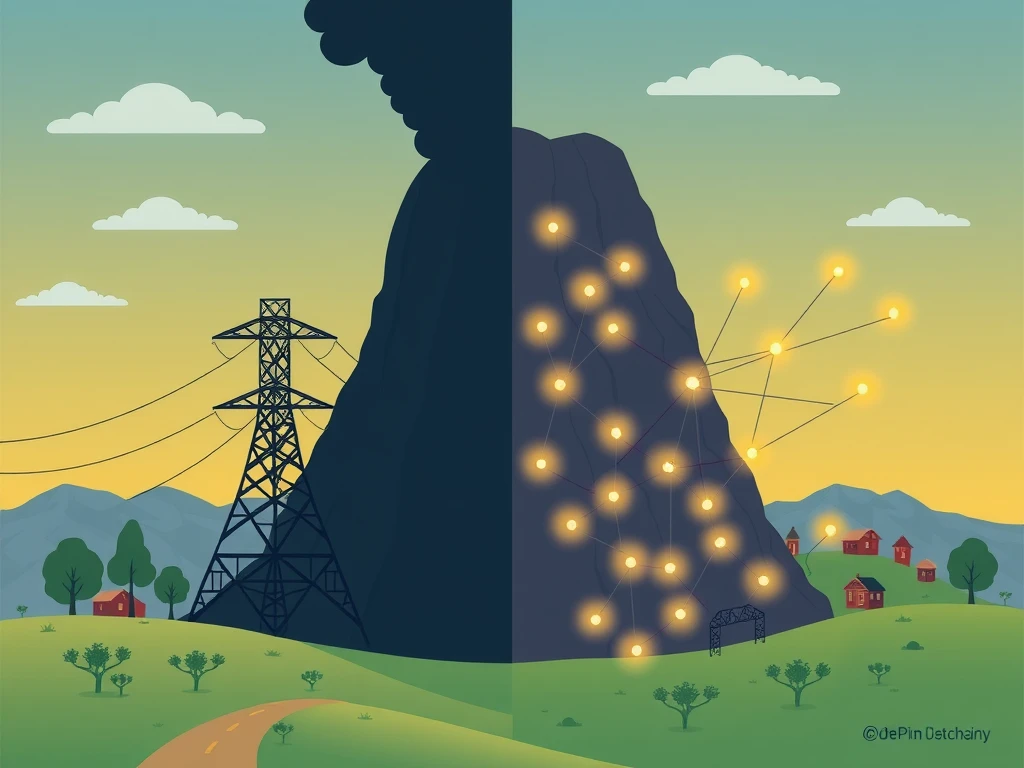Urgent: Centralized Infrastructure Failures Demand DePIN Adoption for Resilience

Recent widespread blackouts and connectivity collapses across continents serve as a stark reminder: relying solely on centralized infrastructure leaves entire societies vulnerable. For anyone involved in the cryptocurrency and blockchain space, these events underscore the critical need for robust, decentralized alternatives. This is where DePIN, or Decentralized Physical Infrastructure Networks, moves from a niche concept to an essential solution for building resilience in our most vital systems.
Why Centralized Infrastructure Fails
We’ve seen it happen repeatedly. Power grids fail, communication lines go down, and essential services are disrupted. The incidents mentioned – from Europe’s blackouts to power woes in South Africa and the Texas freeze – are not isolated. They reveal fundamental weaknesses in aging systems never designed for today’s digital demands and environmental pressures. Integrating renewables adds complexity, and the sheer explosion in digital consumption puts unprecedented strain on existing infrastructure.
The core issue? A single point of failure. When a centralized system falters, the ripple effect is catastrophic, leaving millions without power, communication, and basic necessities. This fragility highlights the urgent need for a different approach – one that distributes risk and empowers local communities.
DePIN: Building Decentralized Infrastructure for Resilience
This is precisely where DePIN offers a compelling answer. Instead of monolithic corporations controlling critical services, Decentralized Infrastructure leverages blockchain technology and token incentives to coordinate individuals and businesses in building and maintaining real-world networks. Think of it as crowdsourcing essential services.
How does this work in practice? Here are key aspects:
- Community Participation: Everyday people and businesses contribute resources like internet bandwidth, storage space, or energy generation capacity.
- Token Incentives: Participants are rewarded with cryptocurrency tokens for providing and maintaining the infrastructure.
- Blockchain Coordination: The blockchain ensures transparency, security, and automated coordination of the network.
- Reduced Single Points of Failure: With infrastructure distributed among many participants, the failure of one node doesn’t bring down the entire network.
This model is not limited to just digital networks. It holds immense potential for energy grids, supply chains, and other forms of Physical Infrastructure.
Achieving Network Resilience Through Decentralization
The primary benefit of adopting DePIN is enhanced Network Resilience. When a centralized system goes down, decentralized alternatives can often continue operating locally or find alternative routes for data and services. This was demonstrated after Hurricane Sandy in Red Hook, Brooklyn, where a local mesh network provided vital communication when traditional systems failed.
Consider these points:
- If cell towers are offline during a disaster, a local DePIN Wi-Fi mesh network could provide essential connectivity for emergency communication.
- A community-managed microgrid using DePIN could keep power flowing locally even if the main grid is down.
- Decentralized storage networks could ensure access to critical data even if a centralized server farm is compromised.
This ability to withstand shocks and maintain functionality is paramount in an increasingly unpredictable world.
DePIN is Not Just Theory, It’s Happening
Examples like the Tibetan exiles in Dharamsala building a wireless mesh network from scrap prove that decentralized infrastructure is not just theoretical; it’s a practical solution born out of necessity. While not always labeled ‘DePIN‘ historically, these community-driven efforts embody the core principles.
Furthermore, DePIN can complement, not just replace, existing systems. Initiatives like OpenRoaming, which federates millions of Wi-Fi hotspots, could be enhanced by a decentralized layer built on Blockchain Infrastructure. A DePIN approach could map, validate, and even expand such networks by integrating community-owned access points, filling coverage gaps and making the overall system more robust and accessible.
Time to Prioritize Decentralized Infrastructure
These infrastructure failures must serve as a wake-up call for everyone with a stake in essential services – governments, corporations, and citizens alike. Betting solely on centralized systems is a risky gamble. Real investment and strategic thinking must be directed towards decentralized approaches like DePIN.
What actions are needed?
- Governments can create regulatory frameworks that support and incentivize the deployment of decentralized networks.
- Telecom and energy companies can explore integrating decentralized nodes and community-owned assets into their planning.
- Public-private partnerships can fund and build shared Physical Infrastructure using DePIN models in vulnerable areas.
Building multi-layered fallback systems that blend the reach of traditional networks with the grassroots resilience of decentralized ones is no longer optional; it’s a necessity for critical sectors like transport, healthcare, and emergency services.
Conclusion: Building a Resilient Future with DePIN
Connectivity is not a luxury; it is critical infrastructure. The recent blackouts highlight the urgent need to harden our digital and physical lifelines. DePIN offers a powerful path forward by distributing control, incentivizing participation, and building Network Resilience from the ground up. By embracing Decentralized Infrastructure and leveraging Blockchain Infrastructure, we can create systems that are less prone to catastrophic failure and more capable of serving communities when they need it most. It’s time to move from reacting to crises to proactively building a more resilient future.
Opinion by: Carlos Lei, co-founder and CEO of Uplink. This article is for general information purposes and is not intended to be and should not be taken as legal or investment advice. The views, thoughts, and opinions expressed here are the author’s alone and do not necessarily reflect or represent the views and opinions of Crypto News Insights.







